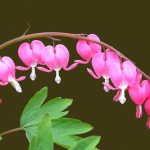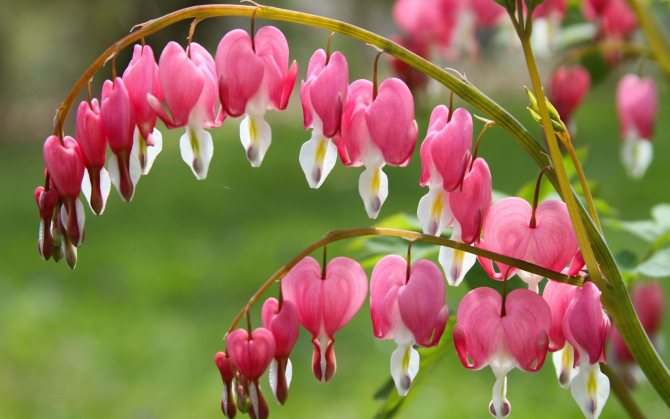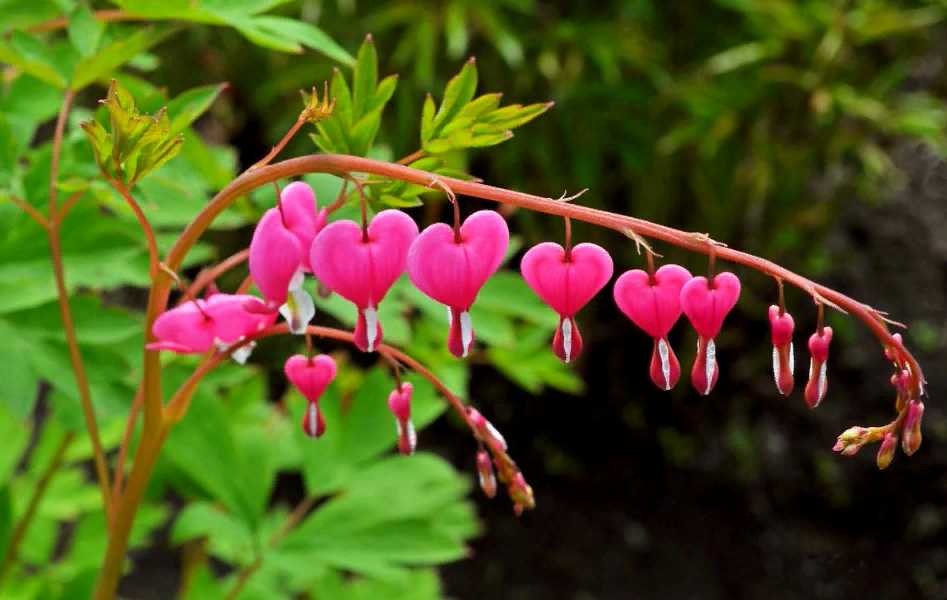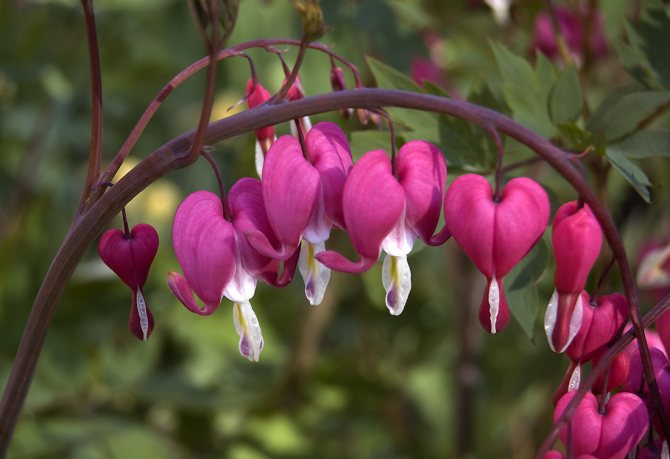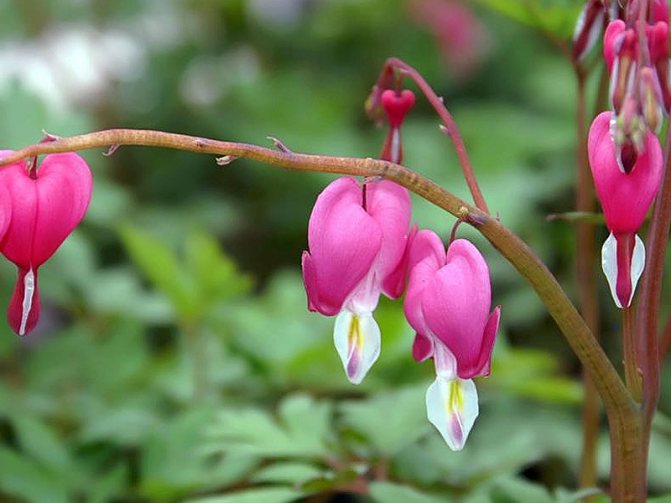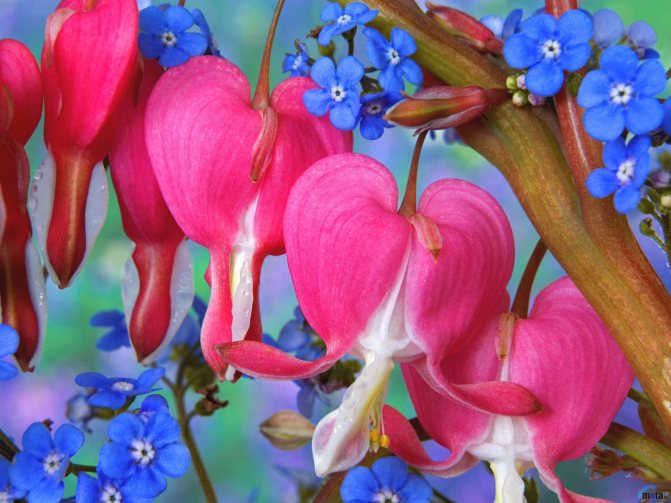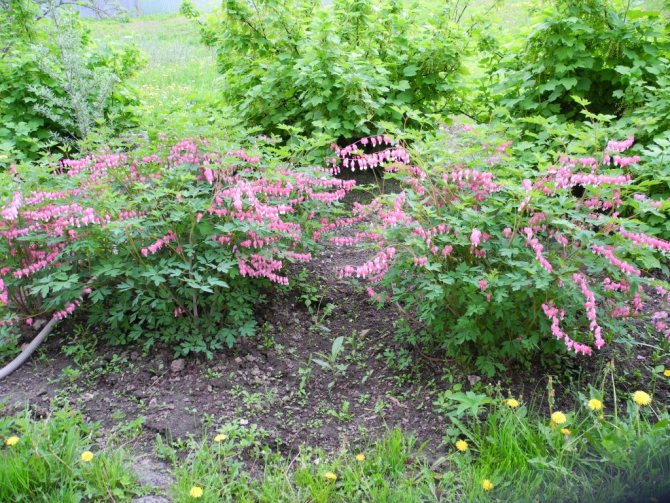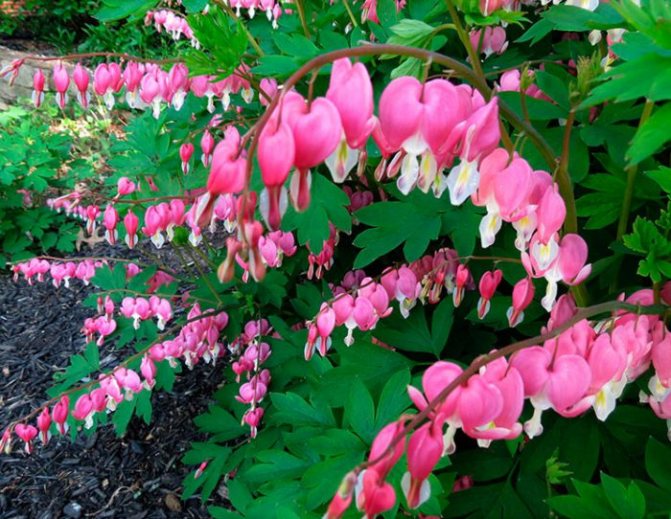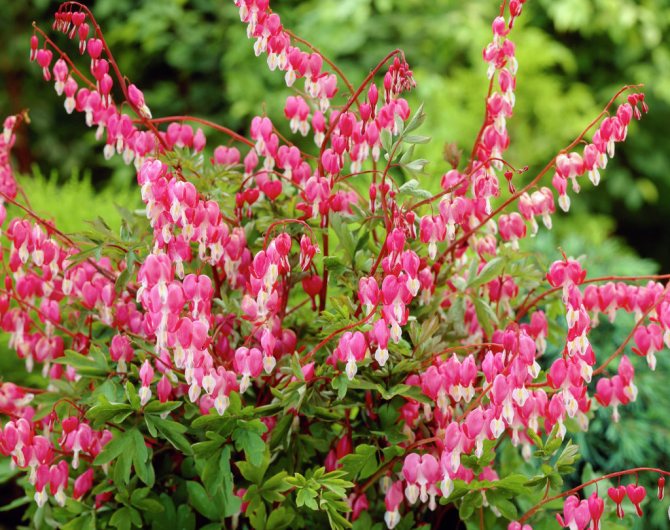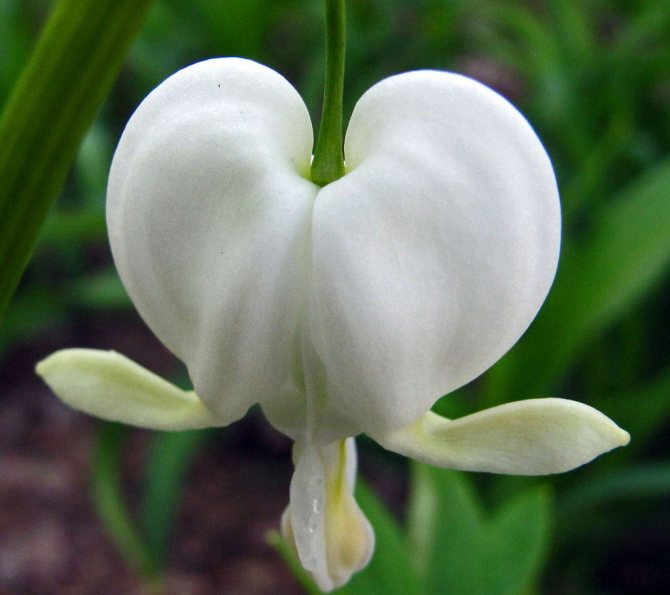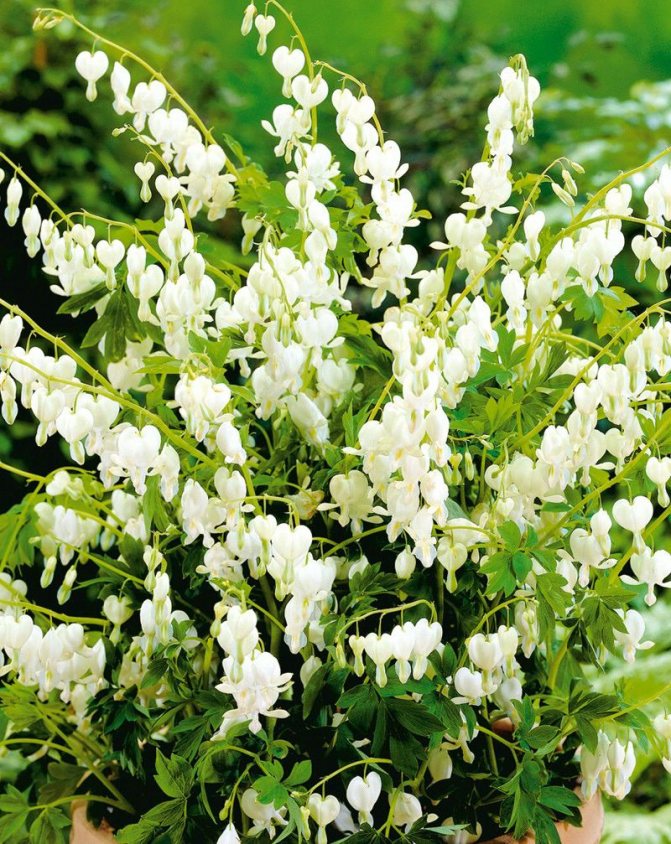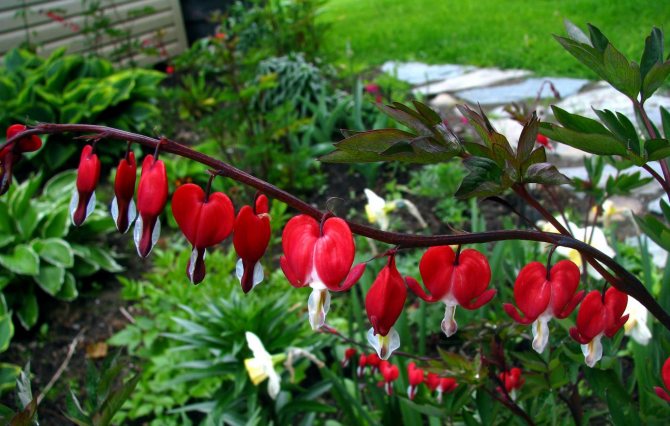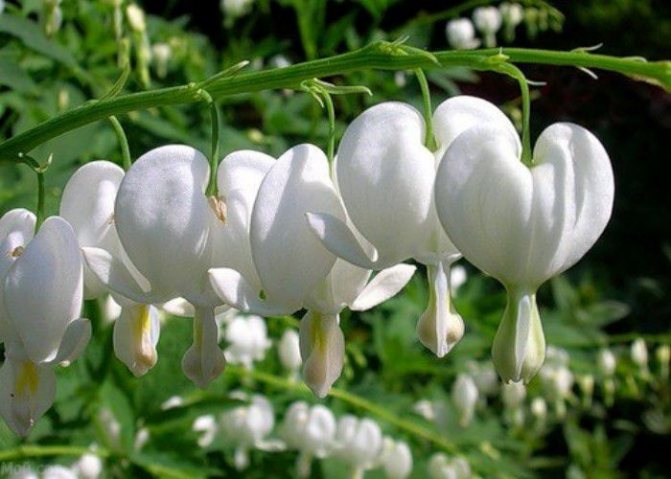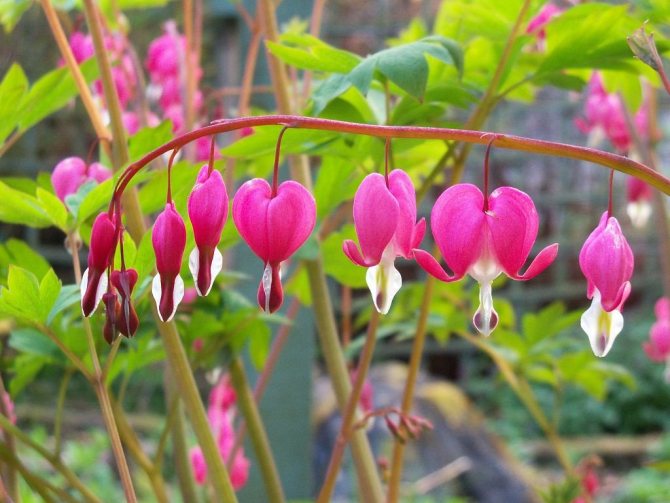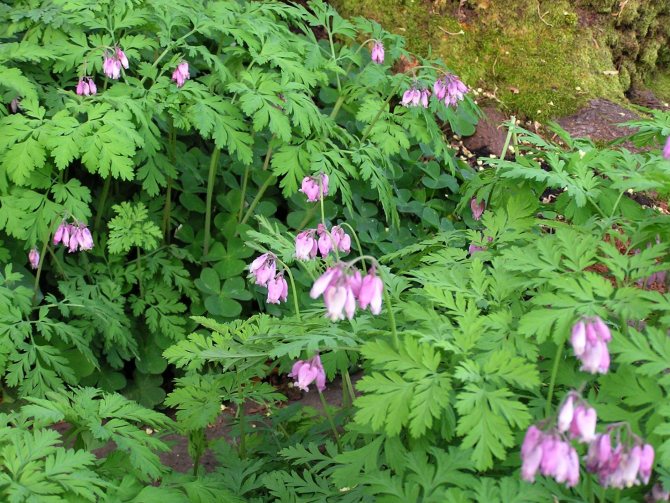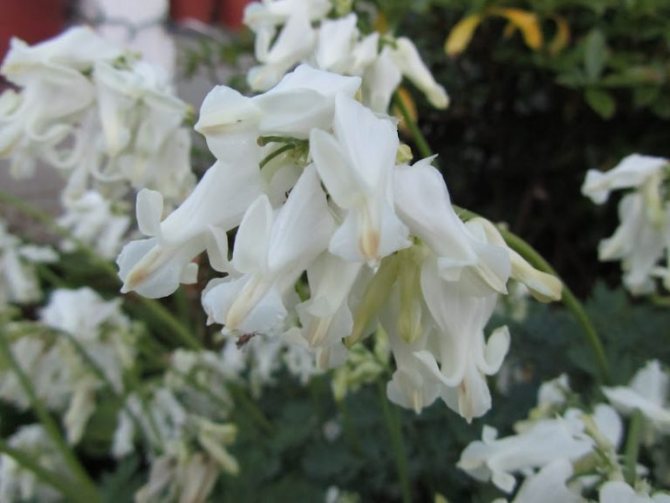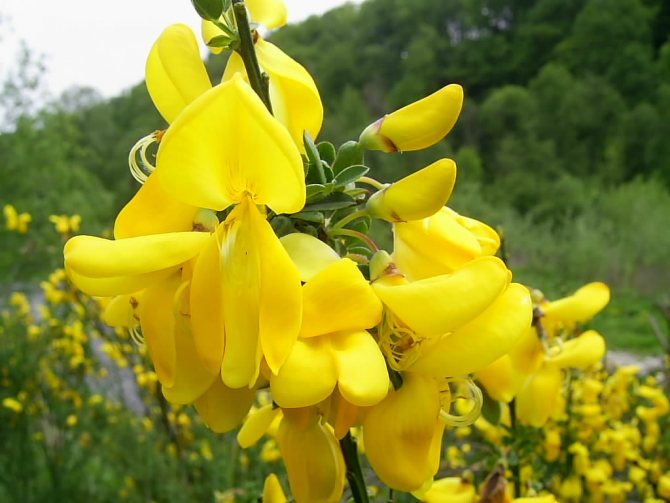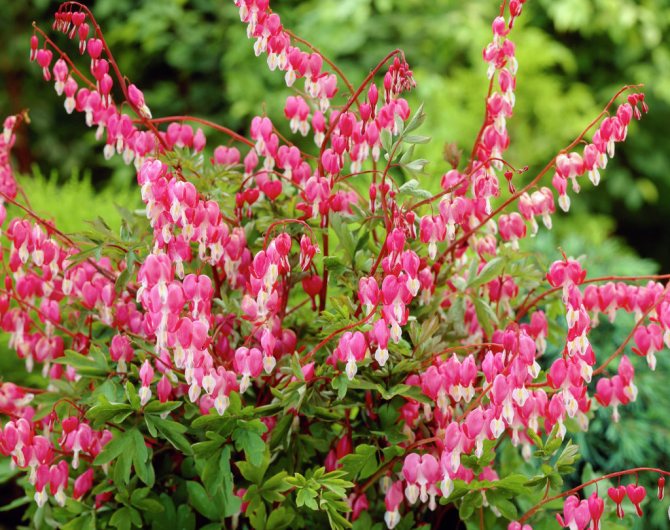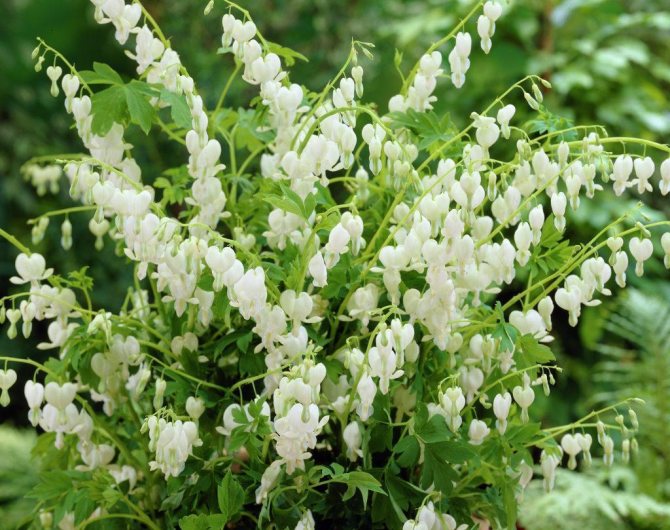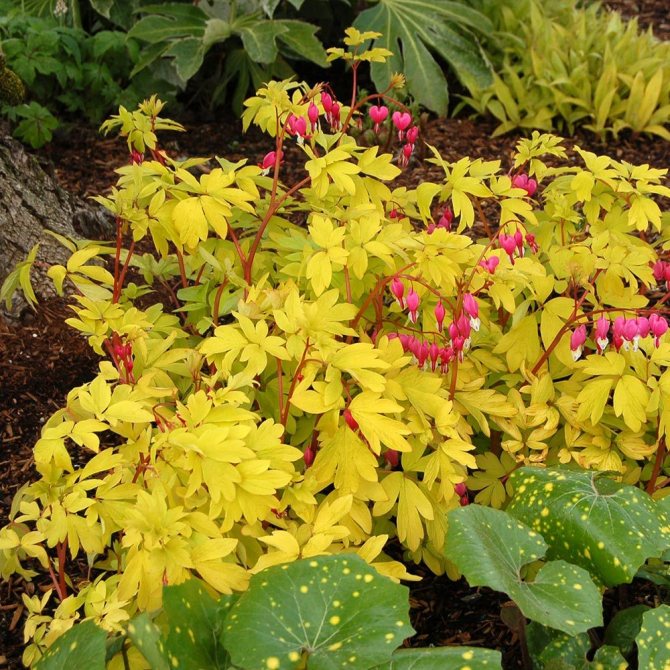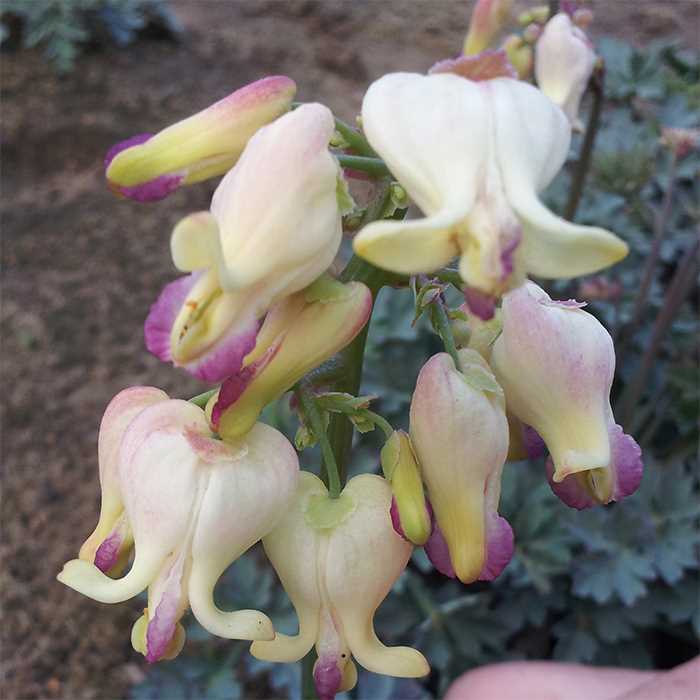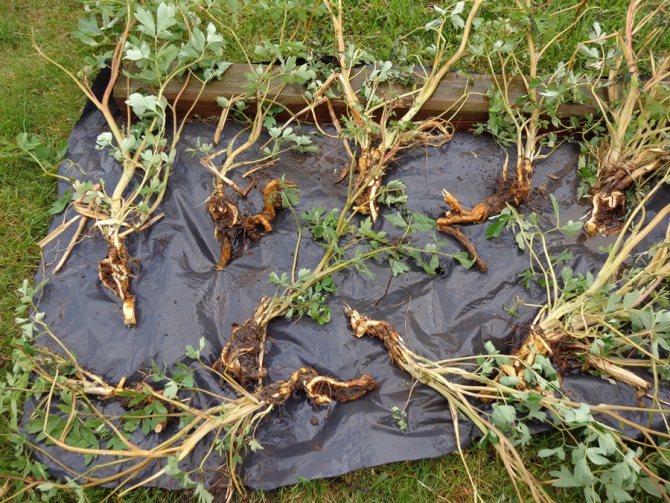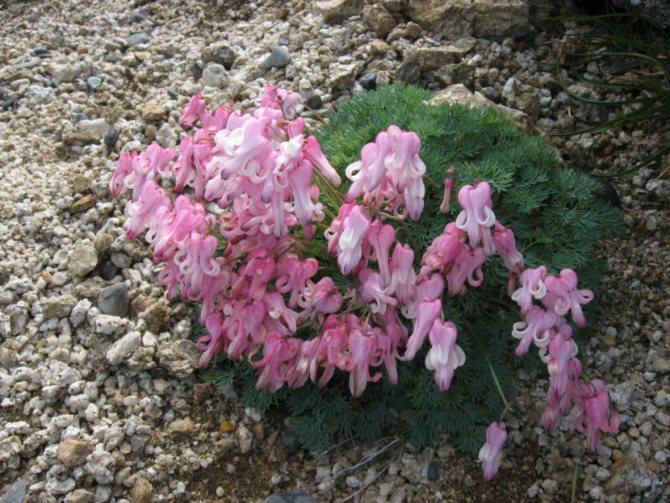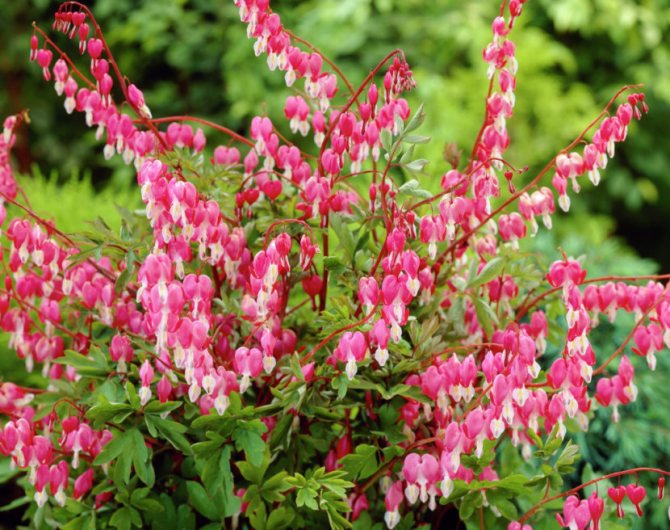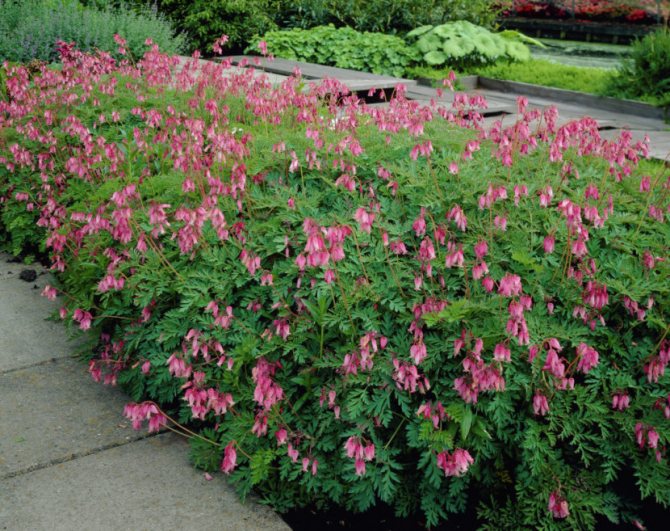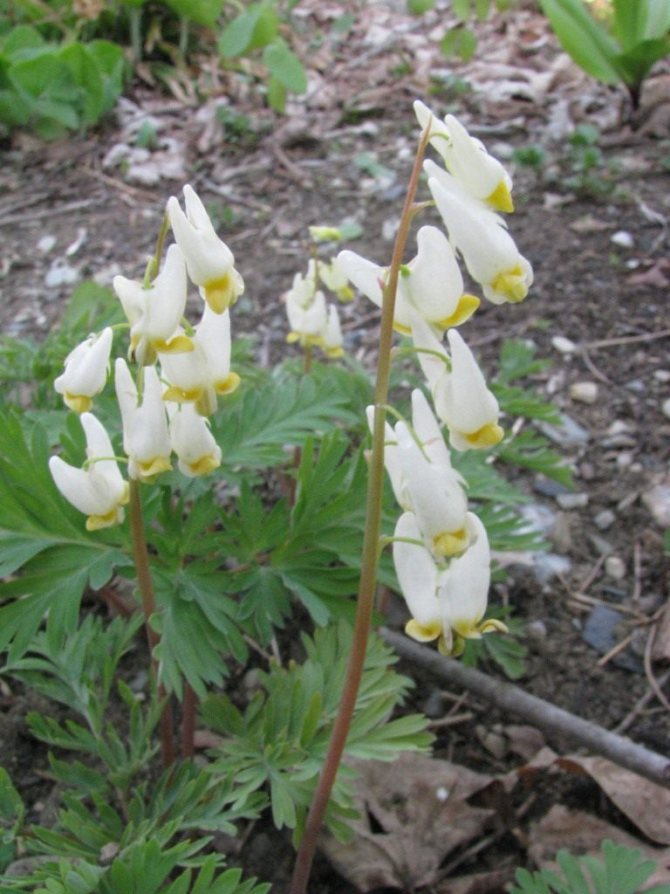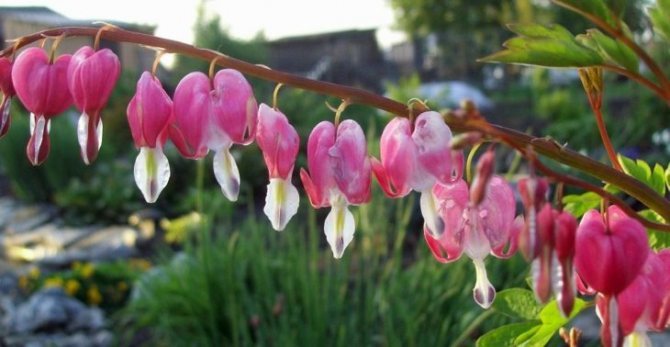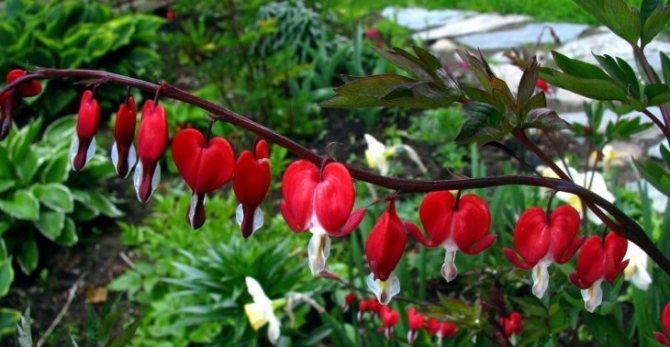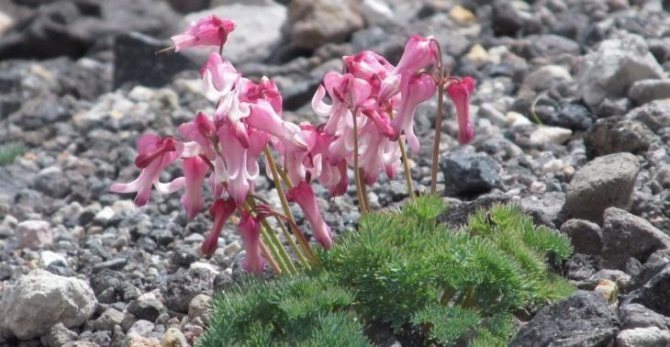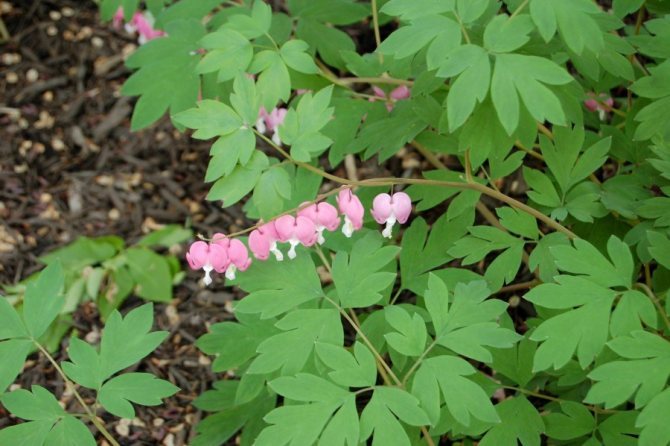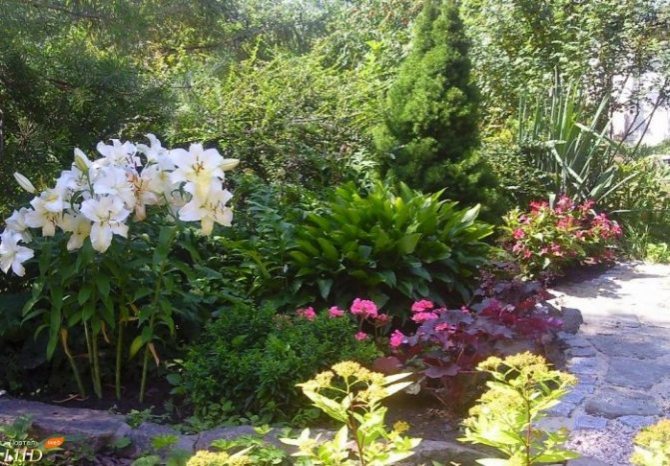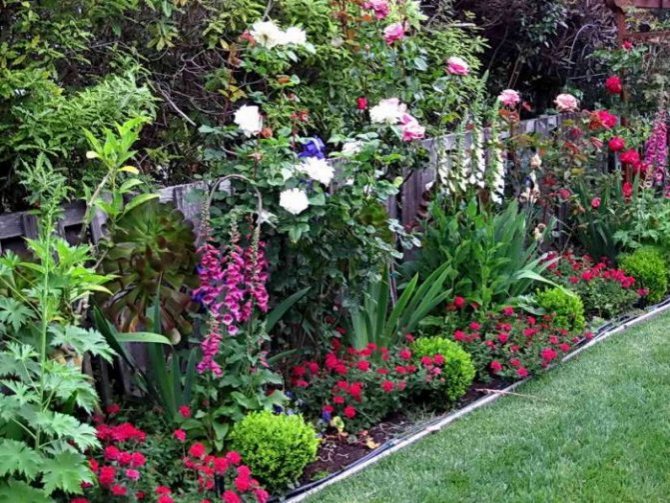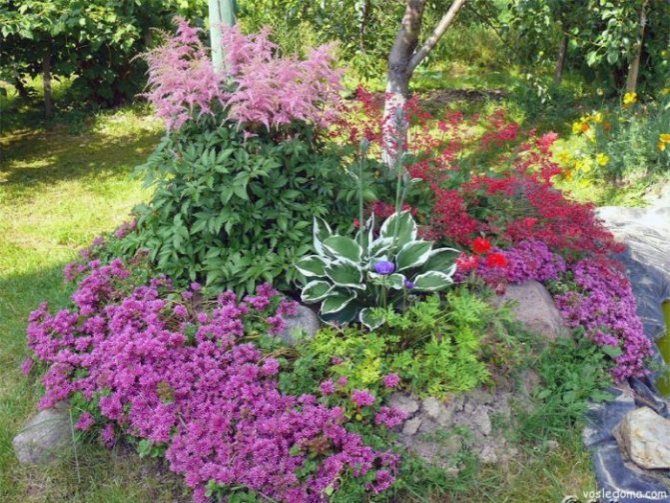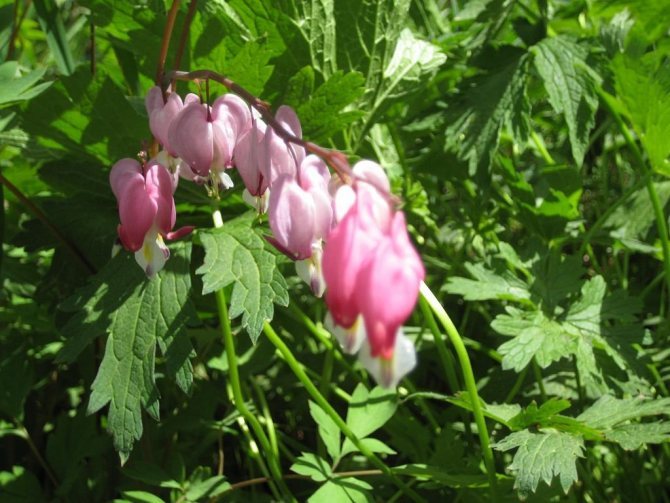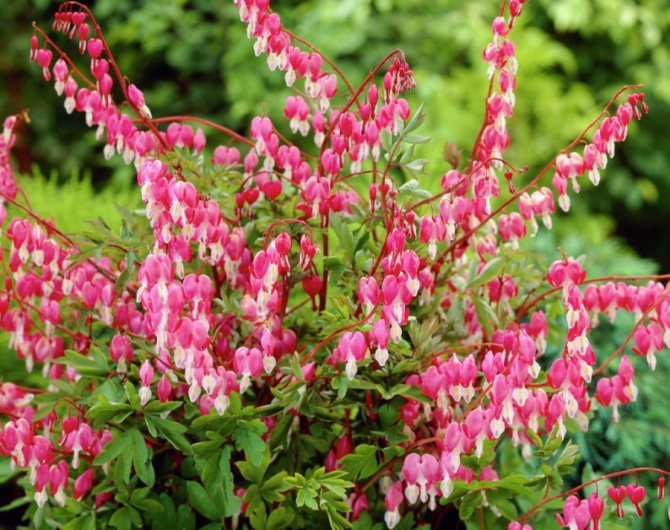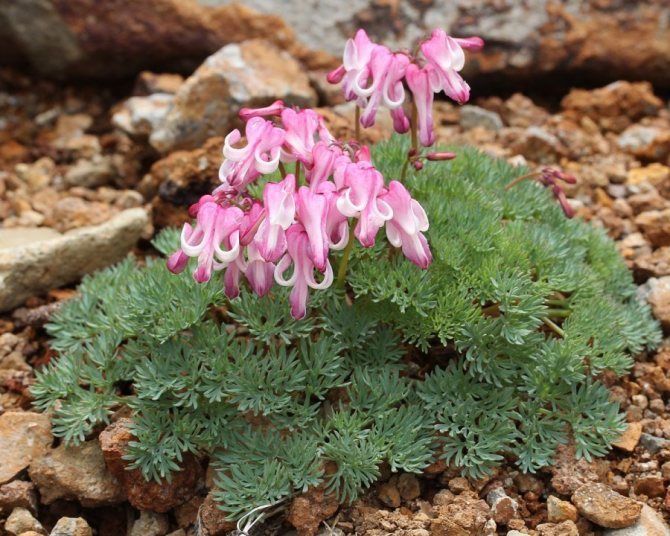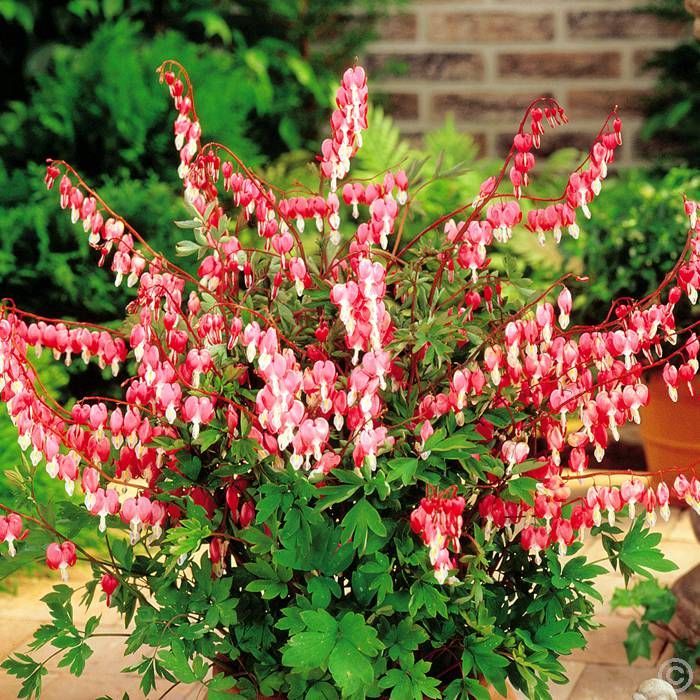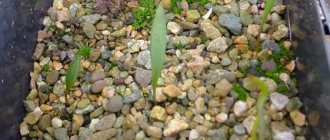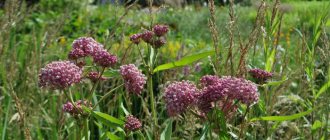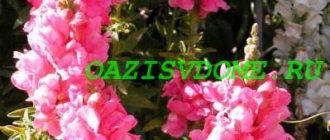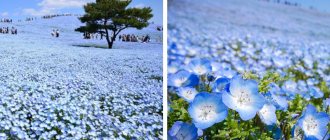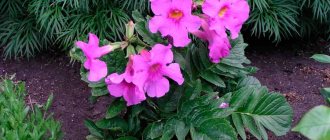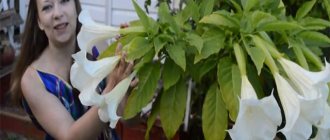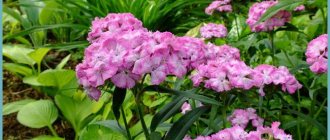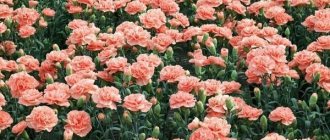Such a beautiful plant as dicentra can become a decoration of any garden. This flower has not lost its relevance for many years and is now actively used in the arrangement of flower beds.
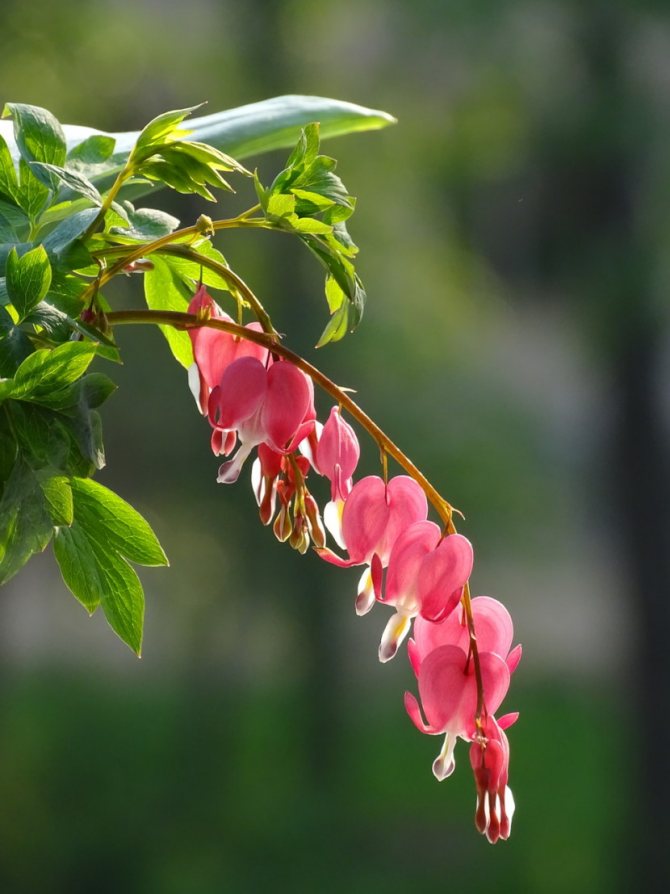
This article will consider the features of planting a dicenter and caring for it.
Types and varieties of dicentra: photo with names
The following types of bleeding centers are suitable for growing in garden plots:
| View | Description | Flowers | Care features |
| Beautiful | Homeland - the northern regions of America. Since the 19th century, they have been used to decorate gardens. Perennial, has a stem 30-40 cm high. Elastic shoots, green leaves, located on elongated cuttings. | Color - from pale silver to deep red. Inflorescences are racemose. | The species is unpretentious, tolerates frost well. |
| Aurora | The shrub reaches a height of 35 cm, grown in one place for up to 8 years. The foliage is pinnately dissected, grayish-green in color. | Heart-shaped, color - white. | At temperatures less than -30 ° C, they are additionally covered. The root system moves deep into the ground to search for moisture, so the flower is practically not watered. |
| Bakchanal (Bekkanal) | Herbaceous perennial plant up to 80 cm high. Carved leaves, gray-green. | They have the shape of a heart pierced with an arrow. The buds are pink or dark red, with a white border around the edges. About 2 cm in diameter. | Unpretentious, planted in partial shade. The species is resistant to frost. |
| Laksharient | Perennial, grows up to 35 cm. Leaves are openwork, carved, color - silvery-green. | Heart-shaped buds. Colors - fuchsia. | The disembarkation is performed in partial shade. |
| King of Hearts | It is one of the most popular varieties of dicentra, reaching a height of 25 cm. The foliage forms a basal rosette, the outer side is green, the inner side is gray. Used in landscape design. | Heart-shaped, purple or pink. | Placed in an open area or in the shade. A transplant is performed every 6 years. |
| Gorgeous | It reaches a height of 1 m. Homeland - China. | Heart-shaped. Pink colour. | In severe frosts, they are additionally covered. |
| Alba | Shrub height - up to 1 m. | White. | To improve flowering, they are placed in nutrient soil, which is regularly fertilized. In autumn, remove all shoots, leave only 5 cm, cover with spruce branches. |
| Dicentra Spectabilis | The bush is about 60 cm high. The foliage is large, dissected. | Inflorescences are racemose. The color is pale pink, with a white border on the tips. | The species is unpretentious, but in severe frosts they make a shelter. |
| Dicentra Eximia | Homeland - North America. It has thick, elongated shoots. | Purple. The peduncle is arched. | The plant is frost-resistant, but in cold latitudes, it is covered with peat and spruce branches. |
| Graceful | Externally, the appearance is similar to a fern. | Pink. | Planted in partial shade, watered 2 times a week. |
| Golden tears | Shrub up to 2 m high. Shoots are strong, but flexible. The foliage is small, oval in shape. | Heart-shaped, deep yellow. | A support is installed and the plant is tied to it. |
| Golden vine | Perennial up to 2.5 m high. Leaves are small, light green. | Large, sunny. | For the normal growth of the flower, a support is mounted. |
| Glomerular | A dwarf species reaching 15 cm in height. The foliage is poisonous, so gloves are used when caring for the plant. The flower is widely used in the pharmaceutical field. | Pink or white. | They are planted in partial shade, watered once a week, pruning is performed in a timely manner. |
| Golden-flowered | Homeland - Mexico and California. It is recognized as one of the largest varieties, reaching a height of 1.5 m. | Golden, with curved petals. | One of the most capricious species, therefore, water it 2-3 times a week, constantly cover from the direct sun, and prevent the appearance of diseases and insects. |
| Single-flowered (Bovine head) | Grows up to 1 m. Homeland - Idaho, Utah. The peduncle is up to 10 cm long. | Singles, color - white with a pinkish tint. The petals are curved. | The plant is demanding to care for, therefore, they perform regular watering, loosening, and feeding. |
| Canadian | It grows up to 30 cm. The foliage is gray-green. | Snow white. | Undemanding, drought tolerant. |


Of these varieties, about 20 varieties are distinguished, which delight with their flowering in spring, summer and autumn.
Planting the dicenter in open ground
When growing plants in open soil, it is imperative to control the planting time and follow the technology.
Landing dates
The flower is placed in the ground in mid-spring, occasionally in early autumn. But when planting in September, they must take into account the moment that the root system must have time to take root even before the arrival of frost. The site is chosen well-lit or in partial shade.
How to plant correctly
Any land is suitable for growing dicentra, but preference is given to light, well-drained, moderately moist and rich in nutrients, soil. The landing site is prepared in advance, for this, the soil is dug to the depth of one bayonet of the shovel and humus is added (3-4 kg of fertilizer per 1 sq. M.), Spilled with a nutrient solution.
Immediately before planting, holes are created to accommodate flowers. Diameter and depth - 40 cm, the interval between shrubs - 50 cm. A drainage layer of gravel or brick chips is placed on the bottom. Pour some garden soil, previously combined with compost. The plant is lowered into a hole and covered with earth on top. When the soil is heavy, it is combined with sand.
Growing from seeds
The seed method of growing dicentra is rarely used. The seeds are quite whimsical, they do not germinate well, especially in temperate climates. But some growers, subject to all the rules of agricultural technology, manage to grow full-fledged flowers from them. The seedling method of growing dicentra is not practiced.
Landing dates
It is better to sow seeds in open ground in autumn. For the winter, crops need to be covered with foil. The main thing is that before the onset of cold weather the seedlings take root on the site and their root system gets stronger.
Spring sowing is also practiced. But the area for growing a flower will need to be prepared in the fall.
Location selection and lighting
Dicentra refers to shade-loving plants. It develops well under the crowns of tall trees. If you plant it in a shaded place, then flowering will come later, but it will last longer. But in direct sunlight, the plant feels worse. It requires constant watering, the flowers become paler and bloom less frequently.
The dicenter will feel comfortable in areas with fertile soil with a slightly acidic reaction. Although it takes root in any soil. Note! The culture is not capricious, but does not tolerate stagnant moisture. Therefore, it is better not to plant it in lowlands, as well as in areas where groundwater is close to the surface.
Soil preparation and sowing seeds
The soil on the site must be nutritious and well-drained. Before sowing, the site must be prepared in advance. If an autumn planting is planned, soil preparation is carried out in the spring. Dig it up, add humus (3-4 kg per 1 m2). Dilute complex fertilizer and apply it to the site. Allow the soil to rest for several months and be well saturated with nutrients.
Prepare shallow holes, water them.Place several seeds in each. Sprinkle with soil. Before frost appears on the seedlings, several true leaves should form. For the winter, they need to be covered with foil. After sowing, the flowering of the dicenter occurs only in the third year.
Features of care for the dicenter
If the place was chosen correctly, and the planting was carried out according to the technology, then there will be no problems with growing the dicenter. But they begin to follow the flower after the first shoots appear, the soil is immediately loosened to create oxygen access to the root system.
Watering, loosening, mulching
The frequency and amount of liquid introduced into the ground are related to temperature. In the warm season, the number of waterings is 2 times every 7 days, in the autumn-winter season - once a week. The soil should not be too wet, as the roots rot.
Weeds around the dicenter are recommended to be removed regularly, cut off withered and dried branches and foliage. After flowering, all trunks are removed under the root, leaving only small hemp.


For shelter from frost, the plant is mulched. After pruning, the remaining parts of the flower are covered with a layer of peat and covered with needles. Remove protection only in the spring.
Top dressing
The plant is fed 3 times:
- after germination - nitrogen-containing agents;
- when buds are formed - superphosphate;
- the end of the flowering period - mullein infusion.
Compliance with the growing regime
A properly planted plant does not create problems for gardeners. Caring for the dicenter provides for the observance of the irrigation regime - it should be moderate.
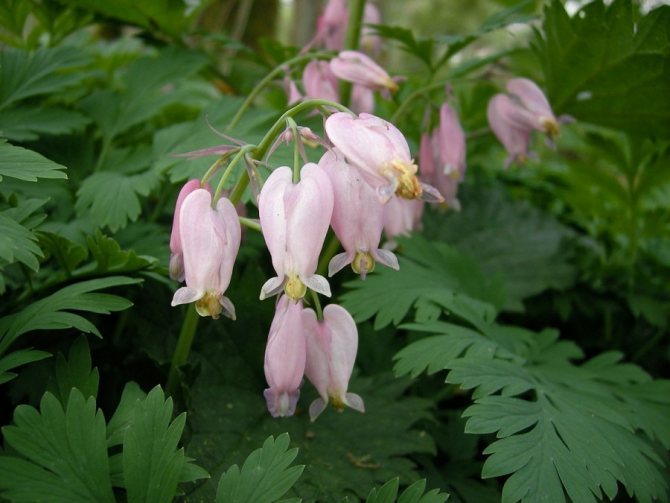

Excessive saturation of water with moisture is not allowed, since the roots may begin to rot. Lack of water is also fatal. Soft water is used for irrigation.
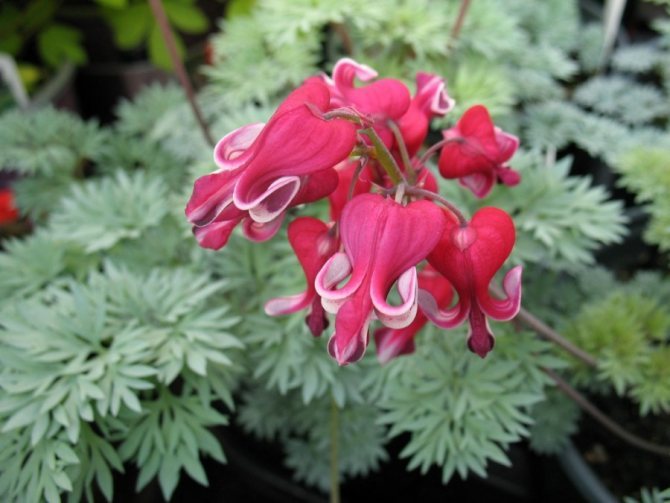

You also need to provide weeding of the flower garden and loosening the soil for better oxygen transfer. Loosening and mulching is done in early spring, when the first leaves appear. Due to the instability of the weather, the bed should be covered with a non-woven material.
Inflorescences that have already bloomed are regularly removed. Also withered leaves are cut to the stumps. To prepare for wintering in regions with a harsh climate, a flower garden with a dicenter is covered with a layer of peat of 5-7 cm. In warm regions, this is not recommended, since there is a risk that the plant will rot.
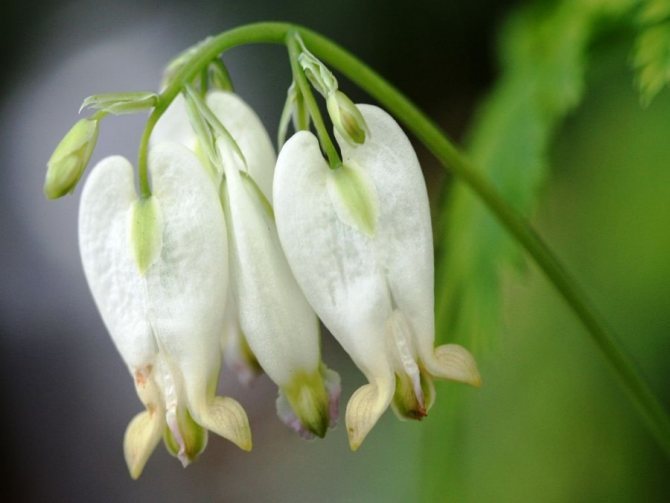

Superphosphate fertilizers are recommended to be used in early spring during the growth stage, nitrogen-containing fertilizers - during the flowering period of the plant. But in the fall, it is advisable to add mullein infusion under the root, and it is also advisable to mulch with a layer of humus.
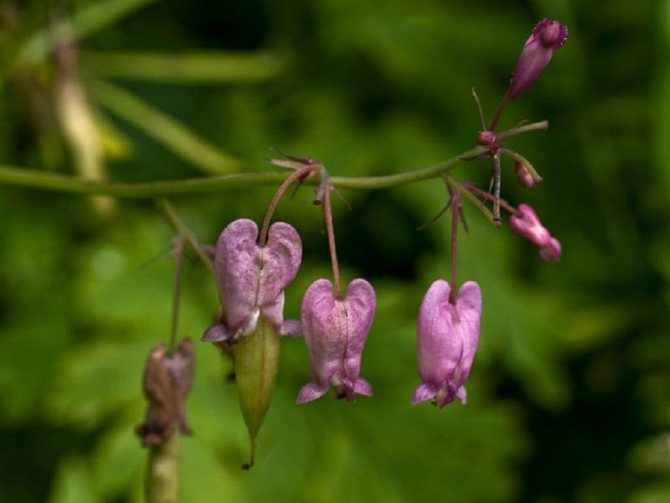

Reproduction of dicentra
Seeds are sometimes used for propagation of dicenters, but this method is rather laborious and unreliable. Germination rate is low, and often completely absent. Among the disadvantages of this method, its duration is also distinguished - growth is slowed down and flowering is expected no earlier than in 3-4 years. Sowing into the soil is performed at the end of September, covered with a film for the winter, and then with straw or leaves.
Many budding gardeners germinate plant seeds in their home. They are placed in special containers with soil, covered with foil and transported to a warm room. The first shoots are expected in 30 to 35 days. When 4 true leaves appear on the flowers, they dive into the open ground. Before transplanting, the plants are hardened; for this, the pots are brought out into fresh air for several hours every day.
The main methods of breeding are considered to be the following:
- Shrub division. Performed every 3-4 years, at the beginning of autumn, immediately after the flowering period. Each separated part contains 3-4 buds. Slices are sprinkled with wood ash, and new plants are placed in pre-prepared holes. If you refuse to divide the root system, then it is subject to decay.
- Cuttings. Carried out in the spring. The resulting shoots up to 15 cm long are placed in a growth stimulator, and then in containers with light soil. The cuttings are covered with plastic cups and transported to any warm room. They are planted in open soil only in the middle of spring next year.
Description of the plant
Dicentra is a perennial herb of the Poppy family. The flower gained popularity thanks to its unusual heart-shaped buds. In France, this culture is called "Jeanette's heart", the plant is associated with the legend of unhappy love. The dicenter was brought to Europe from Japan in 1816, where it gained great popularity among the aristocratic environment. Today it is used for landscaping city parks, it is found in the regions of Russia as a feral plant.
Botanical characteristic
Depending on the species, the height of the bush varies from 30 to 100 cm. It forms a powerful rhizome that goes deep into the ground. On numerous stems there are pinnately dissected leaves, painted in a rich green shade with a bluish tint. White-red flowers, yellow or pink heart-shaped, maximum diameter - 2 cm. Collected in long racemose inflorescences hanging in the shape of an arc. Flowering begins at the beginning of summer, it can last the entire season. The fruit is a seed capsule.
Diseases and pests
The flower has a high resistance to diseases, but occasionally it is affected by ring spot or tobacco mosaic. In an infected dicenter, spots or stripes appear on the leaves, on adults - pale elongated rings. Occasionally, signs of mycoplasma disease appear - the peduncles are curved, growth is slowed down, the color of the foliage is yellow.
To prevent such lesions, it is recommended to water the dicenter correctly, since excess moisture weakens the immune system. The soil is treated with formalin solution.
Of insects, only aphids are dangerous. To eliminate it, the shrub is sprayed with Antitlin or Biotlin. Sometimes the leaf plates are wiped with soapy water.

